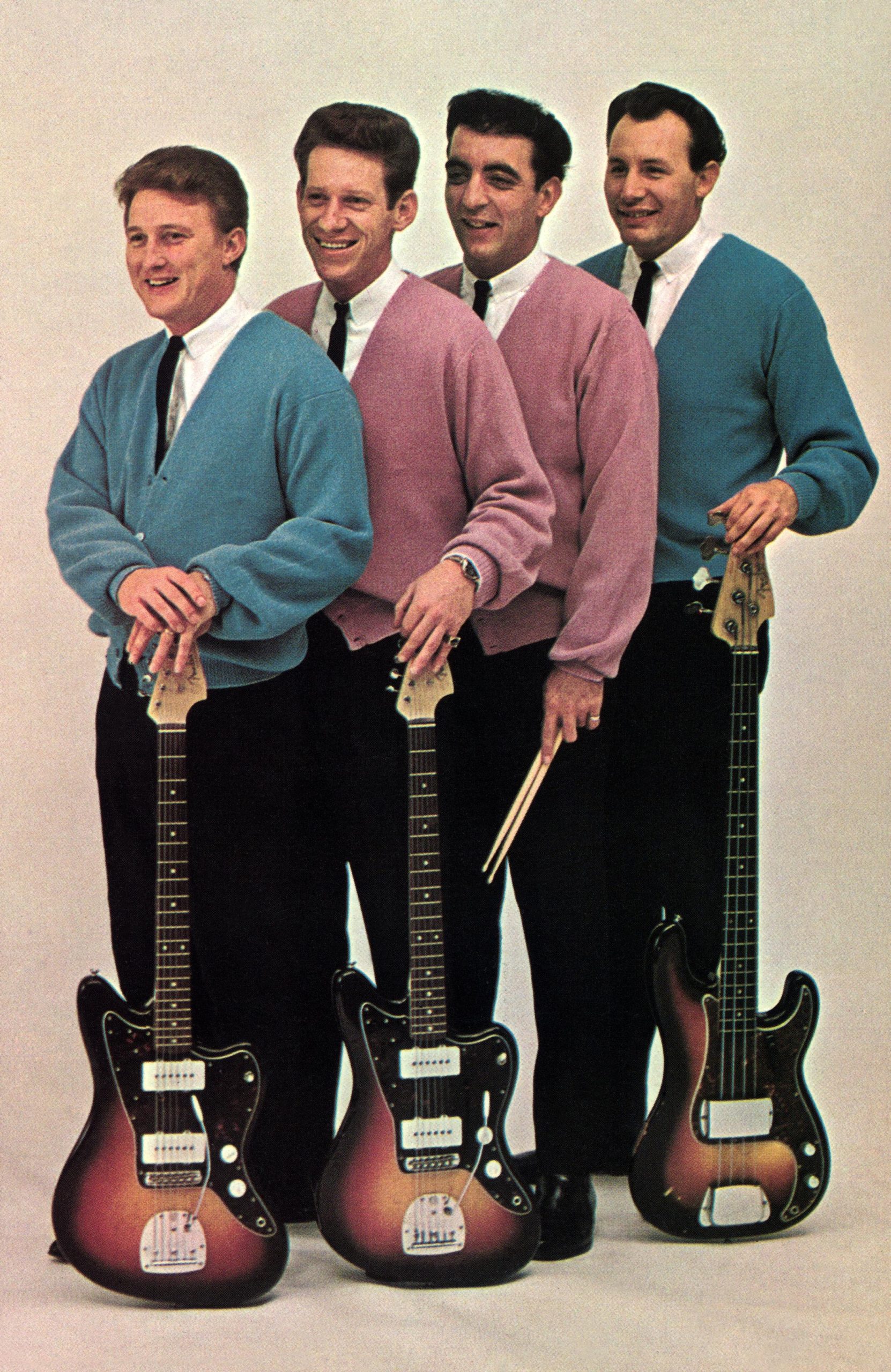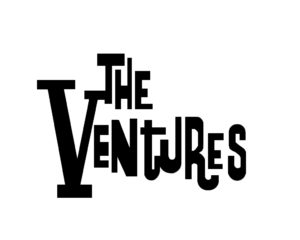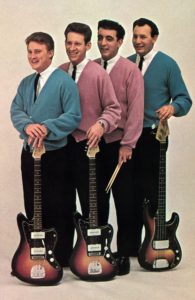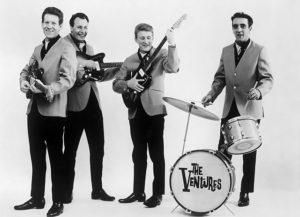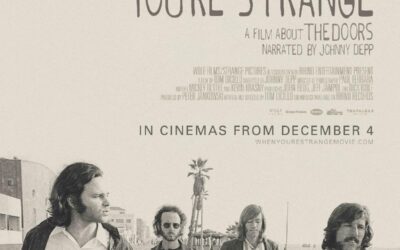At the Grammy Museum in Los Angeles, Ca. December 7, 2019-August 3, 2020
By Harvey Kubernik © 2019
Sixty years after the release of their first hit, “Walk, Don’t Run,” the Ventures are considered the most influential, best-selling instrumental
band in rock and roll history. To showcase the group’s impact on pop culture, guitar players, and their worldwide fan base, the Grammy Museum® in Los Angeles, California has just announced Walk, Don’t Run: 60 Years Of The Ventures, a new exhibit showcasing original items from the group’s six-decade career including instruments, tour programs, never-before-seen photos, vinyl, and more.
The exhibit will open on Dec. 7, and will run until Aug. 3, 2020.
On Jan. 9, musician Jeff “Skunk” Baxter (who has been associated with the Ventures since the 1980’s and has done recordings with them over the years), Fiona Taylor (Mel Taylor’s widow and band manager), and other special guests to be announced soon will be at the museum to discuss stories behind the exhibit with Scott Goldman in the Clive Davis Theater.
“It’s such an honor to have an exhibit dedicated to the Ventures at the Grammy Museum and be recognized for our impact on music history,” said Don Wilson, founding member of the band. “I like to think that, because we ‘Venturized’ the music we recorded and played, we made it instantly recognizable as being the Ventures. We continue to do that, even today.”
Walk, Don’t Run: 60 Years Of The Ventures will offer an inside look at how the Ventures grew to be considered one of the most prolific bands in rock music, having recording more than 250 albums in the past 60 years. The inherent versatility as an instrumental band has allowed the band to explore several musical styles throughout their career, including surf, country, classical, and more. Between 1960 and 1972, 38 of the Ventures albums made it to the charts. Additionally, the Ventures released instructional albums that have made it to the Billboard charts.
Many novice guitar players have credited these educational LPs as a direct influence on their own bands, which has earned the Ventures the honorary title of “the band that launched a thousand bands.”
Exhibit highlights include: A 1965 Ventures model Mosrite electric guitar, Fender Limited Edition Ventures Signature guitars (1996), Mel Taylor’s Gretsch snare drum, and original 45 RPM “Walk, Don’t Run,” and original test pressing of “Hawaii Five-O.”
On a construction site in Seattle, Washington, in 1959, two guitarists, Don Wilson and Bob Bogle, decided to perform together at local sock hops, initially as the Versatones. They added a rhythm section and then became the Impacts for a very short period. Finally settling on the name “The Ventures,” they recorded two songs that Don’s mother Josie released on her Blue Horizon Records label.
The Ventures self-pressed a second single, a cover of Johnny Smith’s “Walk, Don’t Run,” a song that Don and Bob had discovered on a Chet Atkins album.
“Walk, Don’t Run” was a hit single in 1960, reaching Number 2, just behind Elvis Presley’s “It’s Now or Never,” and over the last forty-six years, Wilson and his partner Bogle have subsequently recorded 250 albums and sold 100 million records, 50 million of them just in Japan.
Over the decades the Ventures’ studio and concert lineup included Don Wilson, Bob Bogle, drummers Mel and Leon Taylor, guitarists Nokie Edwards, Gerry McGee, Bob Spaulding, Jeff “Skunk” Baxter, and keyboardist David Carr.
The late, legendary drummer Mel Taylor (Leon’s father), who started out playing and recording with Buck Owens and also anchored the rhythm section on the seminal hits “Monster Mash” (Bobby “Boris” Pickett and the Crypt-Kickers) and “The Lonely Bull” (Herb Alpert & the Tijuana Brass) drove the Ventures beat from 1962 until his untimely passing in 1996.
The Kings of Instrumental Rock, influencing scores of musicians around the world to pick up electric guitars — they endorsed the Mosrite — and strum along to the nearest TV theme or dance craze, including many kids who bought one of their influential instructional LPs called Play Guitar with the Ventures. The group recorded five of those, which became the only instructional albums ever to appear on the U.S. national Billboard charts.
Numerous musicians credit the Ventures with helping them learn their instrument, including Anthrax, the B-52s, Jeff “Skunk” Baxter, Dire Straits, Dave Edmunds, Marco Paroni (Adam Ant), Mick Fleetwood, Aerosmith’s Joe Perry, Johnny Ramone, Jello Biafra, Keith Moon, Gene Simmons, Jimmy Page, Toulouse Engelhardt, Jim Diamond, Chris Spedding, Insect Surfers, Black Train, Gary Pig Gold, Al Di Meola, Max Weinberg, and the Malibooz’s John Zambetti.
The Ventures’ songs have been featured in countless movies and television shows for decades, particularly “Walk, Don’t Run” in Crocodile Dundee and a cable TV movie 61* about baseball players Mickey Mantle and Roger Maris and their home run derby. The Ventures’ recording of “Hawaii Five-0” is in the animated feature movie Madagascar and also played in an AT&T commercial last decade.
“Surf Rider,” a song they wrote and originally recorded, which was later covered by the Lively Ones, was in Quentin Tarantino’s film Pulp Fiction and the companion soundtrack album. The Ventures master recording of “Surf Rider” was licensed to the documentary movie Dogtown and Z-Boys and television’s The Tonight Show with Jay Leno.
In January 2006 the Grammy Hall of Fame added the Ventures’ “Walk, Don’t Run” to their list of the most influential songs in the history of music.
“As a fan and avid record collector of the Ventures, their catalog has always made an impression on me,” confesses Carol Schofield, of MsMusic Productions.
“Their original surf music-themed recordings and cover versions made me think I was at the beach and waves were hitting me. My all-time personal fave is Surfing w/ The Ventures. During November at my High Desert Music record store in Yucca Valley, California I put on counter display from my personal collection a sealed Play Guitar/ the Ventures with the original Woolworth store sticker!”
Dan and David Kessel produced an album and 45 RPM sessions for the Ventures in the early 1980s.
The duo produced the Ventures’ single “Surfin’ and Spying” B/W “Showdown At Newport.” The Go-Go’s Charlotte Caffey wrote “Surfin’ and Spying” and appears on that backing vocal track along with fellow Go-Go member Jane Wiedlin.
In addition, the Kessel brothers also produced a full album on the Ventures, 60s Pop for EMI, later released on a CD, The Compact Ventures, on the Garland label, in 1987.
“One of the fascinating things about the Ventures,” David Kessel told me in 2008, “is their attention to detail and the fact that they cover so many songs that they have to give attention to the melody. Yet, they bring their own interpretation at the same time, by not deviating from the melody, but jamming around it.
“The Ventures have always been ambassadors for instrumental music,” he continues. “They are timeless, international, and sort of like a musical version of (mime) Marcel Marceau. You don’t have to understand the lyrics to get the music. It speaks its own language. When we worked with them, we had their classic lineup. Mel Taylor, a real solid rock drummer, Bob Bogle on the bass, a real good, thick sound, Don Wilson on rhythm guitar, and Nokie Edwards on lead guitar.
“Don Wilson’s rhythm guitar style keeps it open. It’s not like he’s doing these major, hardcore power chord things and totally taking over the trip. The way he plays his chords, and the way they bounce around, really leaves the hole for the bass and the lead guitar. You really need the lead guitar to be up front with the Ventures because that’s where your melody is.
“What the Ventures do on record and on stage,” concludes Kessel, “is that everybody has their spot in the sound if you are going to be heard as an ensemble. My brother Dan and I learned early [they are the sons of guitarist/producer and jazz legend, Barney Kessel], that when you play in a group ensemble you play within the group. You have to understand the place of the instrument and the vocalist, and in the case of the Ventures, their vocalist is the lead guitar. Their visibility, legacy and influence can also be attributed to the fact that the guys had a unique solid sound, and a tremendous work ethic.
“It was very rewarding to play a big part, along with my brother Dan and visionary Sirius XM deejay Rodney Bingenheimer in positioning the Ventures into a ‘New Wave’ renaissance.
“The opening theme song for my radio broadcast The Rockin’ Surfer Show as host ‘Dave The K is ‘Surfin’ And Spyin’.’
David Kessel’s radio show can be accessed at https://cavehollywood.com//the-rockin-surfer-show-with-dave-the-k/
“With over 100 million records sold, the Ventures have certainly earned their place in rock history as the best-selling instrumental band of all time,” summarizes surf music historian Elliot Kendall, noted film and music promoter. “But I have a fond recollection meeting them at Front Page Studio in Burbank in the 90s, via fellow musician Kyle Vincent who was contributing backing vocals to their recordings at the time.
“Drummer extraordinaire Mel Taylor couldn’t have been nicer, such a great hang with him that afternoon. He was the first person to advise me that the band were inspired to learn ‘Walk, Don’t Run’ from the 1957 Chet Atkins Hi-Fi In Focus LP (the one with the supremely cool modern abstract cover that was the winner of a contest sponsored by RCA and Canon Cameras).
“Chet learned the tune from jazz guitar great Johnny Smith’s recording and Smith was the original author of the composition. To experience an illuminating audio family tree, play the Smith, Atkins and Ventures versions back-to-back, to see how much unique hyper-spaced electricity The Ventures ultimately injected into their now iconic 1960 recording of ‘“Walk, Don’t Run.’”
Harvey Kubernik and Don Wilson Interview (2006)
Q: How did you find the Chet Atkins cover version of “Walk, Don’t Run?”
A: My partner Bob Bogle had a Chet Atkins album Hi Fi In Focus. And Chet had a song on it, ‘Walk, Don’t Run,’ and we loved the melody. But Chet played it in a finger style, almost classical, almost jazz. And actually, it was written by a jazz guitarist Johnny Smith. Now, Johnny Smith’s version we never heard. But we were really enamored by that particular song. And so, we couldn’t play it like that. So, we started playing it in the clubs while we were moonlighting after our construction job. You weren’t making any money playing. You got $5.00 a night and played four hours. We played Duane Eddy and a little bit of Chuck Berry. I grew up in the 1940s and loved big band stuff. I picked up trombone and played it all the way through high school.
Q: Where was “Walk Don’t Run” recorded?
A: Joe Boles studio. And prior to us he had recorded a group the Fleetwoods, “Come Softly to Me,” on his label Dolton Records. We had saved our money, and thought when we came into a recording studio we would do something different. And I did a ‘Walter Brennan’ voice in our show, and thought we would do a record like that and cut something like that. And we did. A standard rock ‘n’ roll song, make a stop, I’d say something, so the “Walter” voice. I think we pressed 500 of those and I think we still had 450 of them.
“Then, we started playing ‘Walk, Don’t Run’ in these clubs we were playing in and people would come up to us and say, ‘What was the name of that? The song you played?” I’d say, ‘Walk, Don’t Run.’ And they would reply, ‘Would you play it again?’ And we’d play it twice through the night because we knew we’d had something.
“The audience reaction didn’t really influence the arrangement or tempo of the song, but it evolved somehow. We did 2, 3 or 4 other
instrumentals, like a Duane Eddy, but also something we wrote ourselves. I would say it was about 50 per cent vocals and 50 per cent instrumentals. After ‘Walk, Don’t Run’ was requested so many times, people would come up to us and say ‘Why don’t you record that?’ ‘You think so?’ And we did.
“Not very many takes. 2-track Ampex. You’d have the bass and the drum on one track, and the lead and the rhythm on the other. So you’d have a pretty easy mix. (laughs). But, Joe Boles was very good at getting it right to begin with, even two-track. So he did a good job with ‘Walk, Don’t Run,’ even though you have a bass and drum on one, you’d better equalize them because you’re stuck with that.
Q: And since you had a balance of all the instruments on that record, it seems the lead guitar since has always been out front on the mix or featured a little more loudly sonically, not even counting the lead guitarist in concert situations.
A: That’s very true. (laughs). Our recording was different. We had four pieces. And I told them, ‘I want to hear everyone of them.’ And the way it worked out is that you do hear every instrument. You hear the bass, you hear the rhythm, you hear the lead and you hear the drums.
Q: How did the record breakout in Seattle?
A: As a matter of fact, we befriended a deejay, Pat O’Day, who just came from out of town. And he was a deejay for a very small station, and these were the only people who would talk to you. You could never get to the big station. ‘Who are you?’ As luck would have it, Pat went to the biggest station in town, KJR. If it were not for him we might not have gotten that first record played. What Pat would do was use songs as ‘news kickers,’ and take a song, and they had the news five minutes before the hour. And he would play a song, and not say who it was or who it is, and this is how they would find out if the audience, the listeners would like that song. And, when ‘Walk, Don’t Run’ was played the switchboard lit up. And Pat didn’t have a piece of the record! (laughs).
“So, Bob Reisdorf who had Dalton Records in Seattle heard it, he had the Fleetwoods, and he forgot that we had already brought ‘Walk, Don’t Run’ to him four months earlier, and he passed. No one wanted the record. We went around trying to sell ourselves, and with help from my mother we started the Blue Horizon Records label, and did a previous 45, ‘Cookies and Coke’ b/w ‘The Real McCoy.’ Then later we pressed up ‘Walk, Don’t Run.’
“So, Pat played it as a ‘news kicker’ and it immediately went to number one. Three weeks. Then, Bob Reisdorf called from Dalton, who called the station, ‘Who is that and where are they from?’ And Pat said ‘They are local. They live here.’ Bob said, ‘that’s a natural, I want to talk to them.’ Didn’t even remember we were in earlier playing it for him. So, he liked it before he heard it on the radio. The song wasn’t an immediate hit somebody thing.
“Years later, we were out touring and the songwriter, Johnny Smith wanted us to come over and had lunch. He was making a few schekels on that. (laughs). He said to me, ‘If you hadn’t called that ‘Walk, Don’t Run’ I might not have recognized it.’ That’s what he told me. That melody is so unique.
Q: “Walk, Don’t Run” then become a huge national and international hit?
A: We signed to Dalton, who was distributed by Liberty Records, and Bob Reisdorf was told by Liberty head Al Bennett ‘I don’t think it’s a hit.’ And, Bob said, ‘I’ll guarantee it. If it loses money I’ll pay it.’ ‘OK. If you want to make that deal that’s fine by me.’ And it started climbing up the chart and went to number 2 in the nation.
Q: When drummer Mel Taylor joined the band in 1962, after your sixth album, he had already played on “Alley Oop” by the Hollywood Argyles, “Monster Mash” from Bobby Boris Pickett, and “The Lonely Bull,” the huge hit instrumental by Herb Alpert and The Tijuana Brass. Mel really brought a lot to the Ventures after joining when drummer Howie Johnson had to leave the band in 1962 after injuries from a traffic accident.
A: Well, in 1962, for one thing, we needed a drummer. We listened to Mel play one night at the Palomino Club in North Hollywood. That’s where we met him. But he was ‘Gene Krupa School,’ and played a lot of different things that most rock drummers didn’t play at the time. And we wanted him to join.
“We had chemistry with Mel. It worked very well. He just stepped right in and we got along great. It’s important to that as far as I’m concerned you like the person you are working with. There’s a lot of groups who stay together and they are not happy with each other or ride in the same car. We were always good friends, and go out for dinner.
“Luckily, we were smart along the way, and picked up ways of picking up vocals putting them into instrumentals. And ‘Venturising’ them, if you will. That was for band survival and for selling albums, too.
Q: Where did the concept come from where you and the group started recording and covering television and movie songs that were included in albums and your repertoire? Like “Batman” and “James Bond.”
A: If you play “Walk, Don’t Run” all the time, it’s just not gonna happen. We were looking for anything we could do, and those TV themes were mostly instrumental songs, 9 out of 10. That was a natural for us to go on instrumentally.
“And the songs could work without the visual. They were cinematic in nature, and minor keys we love. And that’s one of the reasons we got so popular in Japan. Minor keys are very prominent in Japanese music. And, there was no language barrier.
“Our agent Tats Nakashima told us, ‘Your music is intimate, and people want to see you play it. I could put you in a ball park right now but listen to me, I don’t want to. I think you guys need to play places that hold no more than 5,000 or 6,000 people.’ And there were venues all over the place like that.
“When we came back in 1964 to Japan we played places that held 4,000 people, and played three times a day there and they were lined up five a breast around the block.
“Now we’ve been stuck with that (laughs). One year we did 108 concerts in 78 days. We ate Kobe beef and raw fish before a lot of people. I love it.
“When we hit, teenagers were ready to play guitar and we just brought it to them. We went back to Japan after the Beatles played there. At first I wasn’t totally into them, it was a little bubblegum. As it went on I recognized their multiple talents, their arrangements and their vocal arrangements, and I thought George Harrison was a good guitarist. Good tone. He cited us in an interview.
“I think that our early learning and our musical appreciation, even before we picked up guitars, were quite different from somebody who picks up a guitar and has only heard and only appreciates rock ‘n’ roll.
“We go back to Frank Sinatra, Bing Crosby, Jerry Vale, so many of these people that we really respected. And we learned those kinds of songs. We learned tunes like ‘Stardust’ after we really started playing, and probably playing not the most perfect chords but good enough. But we were very conscious of playing something that sounded not right. There could have been better chords, no doubt about it, but they weren’t bad chords. I’ve heard a lot of that. And we’d modulate – change keys – in our records. Modulating. We’ve done that a lot of times. You don’t want the damn thing to get boring.
“We had always felt we were a good combination of ears. What I hear, Bob doesn’t hear. And what Bob might hear, I don’t hear. We were basically producing our own things. Most of our producers let us have our head. Neither Nokie nor Gerry McGee plays heavy. They play very light, using their fingers and thumb picks. Bob Bogle, who is really the Ventures’ sound of ‘Walk, Don’t Run,’ ‘Perfidia,’ and ‘Blue Moon,’ the very first thing, plays with a heavy pick, but a great feel. But I still play the same as I would play anyway. I do what I want and I have a good feel for it. If I’m playing an acoustic guitar behind Gerry, I try and be as pretty as I can be. The reason we get along so well is because we don’t step on each other’s toes.
Q: Tell me about your concepts and philosophy regarding the use of vibrato and the tremolo bar also distinguished you from everyone.
A: Yes. Well, you know, there’s a very simple story to that. When Bob and I started, there were not really four piece bands. You either had a saxophone or a piano. Two guitars, a bass and a drum. You need a piano or a saxophone. We didn’t know a drummer or a saxophone player. So, he and I when we started learning, I played very percussion rhythm, and he played with a vibrato, and coming to certain notes with a chord to make the sound even more full.
“So the two of us together tried to make up for drum, piano or whatever else. And the whole thing was when we did get a drummer and a bass player that stuck with us. That was our style and the way we played. A lot of people come up and say ‘How do you get that sound?’ Well, it’s not a matter of getting it. That’s what we do.
Q: Your Ventures In Space is very popular. It was one of Keith Moon’s favorite all time discs. He told me his first group was the Beachcomers and that he learned to play along with the pedal steel on that LP. No gimmicks.
A: That’s true. I’m surprised, but many followers of the Ventures, it is their favourite album. I don’t know if it has anything to do with not using anything electronic. We had a steel guitar player, Red Rhodes, he was absolutely great, and he put the first fuzz tone together. He owned a couple of equipment patents and he could play anything. But, using his steel guitar, and all the things he could come up with sounds, and all the sounds that we could come up with, and we tried, we accomplished, using no electronic at all. I think that impressed a lot of players.
Q: One of the most popular albums is your Play Guitar With The Ventures. The impact of that album is monumental with a great package with an instructional booklet.
A: Thank you, the first and only since that ever hit the charts. An instruction album that hit the charts and we had five of them. At one time
we had five albums in the Top 100 at one time that hit the charts like Bobby Vee Meets The Ventures, and a country thing. Someone came in with an idea for an instructional album and that it would be good for us. We didn’t mind giving some secrets away. We’re pompous enough to think that nobody is gonna cop our sound regardless of what we tell them. I think it helped a lot of guitar players and they still come up to me and say ‘I learned to play off that album.’
Q: Guitarist Gerry McGee first came along in 1968, added something to the lineup. He’s on the early Monkees recordings and Delaney, Bonnie & Friends. I saw him blow an audience away in L.A. when he subbed for Henry Vestine in Canned Heat at a New Years’ Eve 1969 show at the Shrine Exposition Hall.
A: He can play anything. He shows up and plays his tail off and he’s got a feel that won’t quit. The tempos are faster on stage. I can remember the first time we played on stage in Japan. I can’t even believe how fast those songs were. They’re triple out of nerves. Trying to satisfy, not drag anything and we overdid it.
Q: Instrumental music in general. There’s always a place for it on the dial and in the record bins. You have always filled a welcome void.
A: Yes. I think that our early learning and our musical appreciation, even before we picked up guitars were quite different from somebody who picked up a guitar and only has heard and appreciates rock ‘n’ roll. We go back to Frank Sinatra, Bing Crosby, Jerry Vale. So many of these people that we really respected. And we learned those kinds of songs. We learned tunes like ‘Stardust’ after we really started playing, and probably playing not the most perfect chords but good enough. But we were very conscious of playing something that sounded not right. There could have been better chords not doubt about it but they weren’t bad chords. I’ve heard a lot of that. And, we dropped keys in our records. Modulation. We’ve done that a lot of times. You don’t want the damn thing to get boring.
Q: One other aspect of the Ventures music is how your recordings continually are in movies and television shows like Hawaii Five-0.
A: Mel Taylor knew an engineer he worked with a lot named Ted Keep. He did the engineering for that TV show. Source music. He came to Mel and said, ‘They are starting this show and it’s been on for a month and the writer/composer, Mort Stevens only has a thirty second version of it and he does not plan to do a regular commercial release, and I think you guys should come in and do it.’
“So we did. The record company hired 35 pieces, all brass, and we copied his version but with a guitar lead over the top. And his version did not have that.
“We put it out in July 1968 and no one would play it. Then the show started getting better, but we still weren’t getting any airplay. So we hired an independent promotion man. He was real good and a go-getter. No one was promoting it and we said this is good and used our own money. We bit the bullet for a month or six weeks. Then the show’s scripts got better and then he got it played and to number one in one city. In Honolulu!
“Anyway, he happened to know somebody who was a deejay who then became the program manager in Sacramento, California, and he started to play it as a favor to this guy. And it went to number one and it started spreading everywhere and it took seven months.
Q: Does it ever get tired or predictable that you are now in decades of playing ‘Walk, Don’t Run’ nightly. I know people are paying money and want to hear it. Are you trapped by your past or are you in conflict about repertoire?
A: Never. I love to play it. We all have no qualms about playing it over and over. Now, Nokie Edwards quit, more than once, owing a little to ‘I’m so tired of playing those songs.’ Bob and I, along with Mel, we know the audience loves it and want to hear it. We enjoy playing. I love to see the faces when we are playing ‘Walk, Don’t Run.’
Q: Jimi Hendrix was from Seattle. He saw the Wailers live, and Dick Dale at least a couple of times, too and heard the Ventures during 1960-1962.
A: I wore out his first album with ‘Hey Joe,’ ‘Foxy Lady’ and ‘Fire.’
When we first started in 1960, songs were 2:20, ‘Walk, Don’t Run.” and ‘Hawaii Five-O’ is 1:50. In 1960-1965, if you played a song longer than 2:20 most disc jockeys wouldn’t play it, for a single. Then later in 1967 and ’68 Hendrix took it into a whole other world.
“He was amazing to watch. I did see him play live a couple of times in Seattle, probably 1967. ’68… Blew my mind… Amazing. I think it was his technique, and the way he hardly ever looked at the neck of the guitar. It was like he was in another world and playing those things you shouldn’t hear from a guitar. I think he was an innovator.
Q: Jimi was into science fiction. The Ventures even did psychedelic and space-titled long players.
A: In early ’67, a local L.A. deejay, The Real Don Steele on KHJ came to us and said, ‘There’s something coming up called psychedelic and you guys should get on that right away because it’s really gonna be something.’ OK.
“So we did the Super Psychedelic album released in June of ’67. We stretched out on that album. I really like it. We were older than the other psychedelic bands, wore velours and our hair was shorter. Man, red blazers, black ties, and white bucks. Drummer Keith Moon of the Who decades ago cited Ventures in Space.
Q: Man, you must have met every guitar geek on the planet digging your action.
A: For sure, for sure. They initially chose, or still utilize a Mosrite because of us. You put a Mosrite Guitar out without the Ventures name what do you got? They were impressed and it had our name.
“The most interesting one lately is Al Di Meloa who told me he learned to play off our stuff and also the garage bands. Even drummers we have influenced. At NAMM show I saw Mick Fleetwood and he came over. On The Johnny Carson Show many years ago, he was asked his early influences, and the first thing that came out of his mouth was “The Ventures.” And I reminded him of that. (laughs).
Q: I know some real major guitarists that play and are well-known global performers who acknowledge your influence.
A: Here’s a good story. We’re playing the House of Blues a few years ago. Aerosmith came to see us play, and sat at table near my family and friends. My son recognized Steven Tyler and somebody came up to them and said ‘you guys are legends.’ And Steven Tyler pointed to us and said, ‘No. Those guys are legends.’ Now that’s a compliment. Two years ago I’m in Japan, or last summer. Aerosmith is playing the Tokyo Dome. Now, I don’t know Joe Perry. But he and I are waiting for a train. He looks at me and says ‘Are you a musician?’ ‘Yeah.’ And he said, ‘Who are you with?’ ‘The Ventures.’ ‘The Ventures! Can I get a picture?’ ‘Sure.’ And he calls his manager and says, ‘Get over here. This is history!’
“I talked to him all the way on the train. I had no idea they had an autobiography out. So anyway, he says, ‘I’m gonna get you tickets to our show and to come backstage.’ ‘OK.’
“My wife and I went backstage with Leon our drummer. Joe then said it was an honor to stand in front of me and talk. And then he’s on stage he said, ‘My teacher is out there.’ He introduced and brought me out. Everybody knows the Ventures in Japan. The place went crazy and I didn’t even have to play. (laughs).
(In 1964 Harvey Kubernik was the drummer/percussionist of a very short-lived surf instrumental group called The Riptides. In the late seventies he provided handclaps and percussion on recording sessions of The Runaways, the Surf Punks, the Ramones and the Paley Brothers.
Kubernik is the author of 15 books. His literary music anthology Inside Cave Hollywood: The Harvey Kubernik Music InnerViews and InterViews Collection Vol. 1, was published in December 2017, by Cave Hollywood. Kubernik’s The Doors Summer’s Gone was published by Other World Cottage Industries in February 2018. It was nominated for the 2019 Association for Recorded Sound Collections Awards for Excellence in Historical Recorded Sound Research.
During November 2018, Sterling/Barnes and Noble published Kubernik’s The Story of The Band From Big Pink to the Last Waltz.
In 2019, The National Recording Registry at the Library of Congress in Washington, D.C. have asked Harvey to pen an essay on the landmark The Band album, now celebrating a 50th anniversary edition in 2019.
Kubernik’s 1995 interview, Berry Gordy: A Conversation With Mr. Motown appears in The Pop, Rock & Soul Reader edited by David Brackett published in 2019 by Oxford University Press. Brackett is a Professor of Musicology in the Schulich School of Music at McGill University in Canada.
Harvey joined a distinguished lineup which includes LeRoi Jones, Johnny Otis, Ellen Willis, Nat Hentoff, Jerry Wexler, Jim Delehant, Ralph J. Gleason, Greil Marcus, and Cameron Crowe.
Kubernik’s 1996 interview with poet/author Allen Ginsberg was published in Conversations With Allen Ginsberg, edited by David Stephen Calonne for the University Press of Mississippi in their 2019 Literary Conversations Series.
Harvey Kubernik is featured in the 2014 book by Jeff Burger on Leonard Cohen Interviews and Encounters for Chicago Review Press. During 2015 the University Press of Mississippi published a Harvey Kubernik interview with D.A. Pennebaker in their book series, Conversations with Filmmakers, edited by Dr. Keith Beattie.
This century Kubernik wrote the liner note booklets to the CD re-releases of Carole King’s Tapestry, Allen Ginsberg’s Kaddish, Elvis Presley The ’68 Comeback Special and The Ramones’ End of the Century.
During 2019 Kubernik is serving as a Consultant on a new 2-part documentary on the musical legacy of Laurel Canyon. Alison Ellwood is directing the documentary who helmed the authorized History of the Eagles. Broadcast date is first quarter 2020 on EPIX Television).

